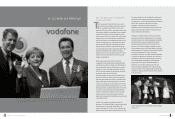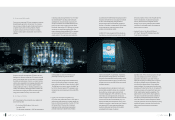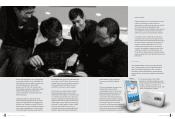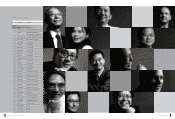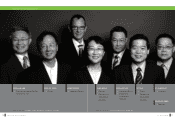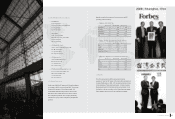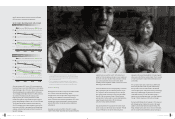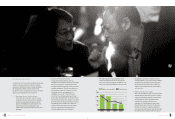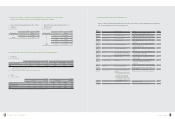HTC 2008 Annual Report Download - page 18
Download and view the complete annual report
Please find page 18 of the 2008 HTC annual report below. You can navigate through the pages in the report by either clicking on the pages listed below, or by using the keyword search tool below to find specific information within the annual report.
30 31
Reflecting its tenacious dedication to innovation, HTC's
successful 2007 launch of its HTC Touch series was quickly
followed by the launch of its flagship HTC Touch Diamond
series of smart phones in May 2008. In September of the
same year, HTC joined with Google and T-Mobile USA to
announce the worldwide launch of the first mobile phone
designed on the Android operating system - yet another
example of HTC leadership in innovation and exceptional
business operations. Against prevalent adverse economic
conditions, HTC maintained strong growth momentum,
shipping 12.03 million units during 2008 realizing an overall
7.5% share of sales worldwide of converged devices.
In terms of key inputs, the negative growth in global mobile
phone shipments that began during 4Q 2008 was anticipated
by cutbacks in production capacity utilization by downstream
component vendors during the 3rd quarter, increased
competition among vendors for mobile phone maker orders,
and vendor-initiated price reductions. The steady easing of
previously tight supplies for small and medium dimension
display panels and li-ion batteries provide the most vivid
examples of the easier supply situation faced by HTC for
critical components. The softening overall market for mobile
telecommunications products that began in 4Q 2008 has also
improved the availability of power amplifiers as well as other
active and passive components.
As overall global shipments of mobile phones are expected to
decrease during 2009, supplies in related parts and
component markets should continue to exceed demand.
While maintaining supply stability, HTC will continue to
pressure suppliers to raise production efficiencies and reduce
production costs in order to realize competitive advantages
that are sustainable and mutually-beneficial. HTC will also
take advantage of the current component oversupply
situation to reduce purchase costs and maximize cost
structures.
B. M arket Analysis
2008 saw increasingly fierce competition amongst smart
phone operating systems worldwide. While retaining its
position as the most widely used operating system, Nokia's
Symbian has seen its overall share of overall unit sales
slide. The joint promotion by Google, HTC and T-Mobile
USA of the first mobile phone based on the Android system
has invigorated the potential for the platform's success in
the global market. In light of current investments by other
mobile phone makers in developing and manufacturing
Android-based systems, Android phone growth prospects
should not be underestimated.
Prospects glow brightly for continued vigorous growth in the
converged phone sector. Rising consumer demand for high
data transfer speeds are leading a general trend toward
upgrading to 3G mobile phones. With the age of the mobile
Internet fast approaching, mobile phone designers and
telecommunication operators are forming the increasingly
close relationships necessary to introduce the diverse and
steadily expanding suite of mobile digital services essential to
meet high market expectations and to encourage consumers
to replace their traditional mobile phone models with new
smart phones.
>Demand
Rapid advances in wireless telecommunications R&D
are making smart phones increasingly light, thin and
compact while delivering interfaces increasingly tuned
and responsive to user needs. Hardware has largely
migrated to 3G technologies, while onboard GPS
systems and touch screen controls are quickly
becoming standard mobile phone features. With
investments in 3G network by telecom service
providers starting to show results and a diverse range
of associated services being offered at ever more
competitive prices, handheld smart phones are
increasingly moving to the 'center' of the mass mobile
phone market.
>Supply
Observing the potential inherent in the handheld smart
phone market, major names in the traditional mobile
phone sector are stepping up their involvement in this
segment. Companies previously not involved in mobile
phones, such as Apple and Google, are also stepping
into the fray. Also, the trend toward developing and
marketing phones designed on non-proprietary
operating systems has opened the field for explosive
growth in the number and variety of mobile Internet
software applications available. Such is already
enriching the development and growth of the mobile
Internet environment.
2OO 8 HTC AN N UAL REPO RT
III. Business O perations
'0 8A R_ HT C/ 英文版* NEW 05/ 14/ 20 09 17: 42 頁面 3 0



